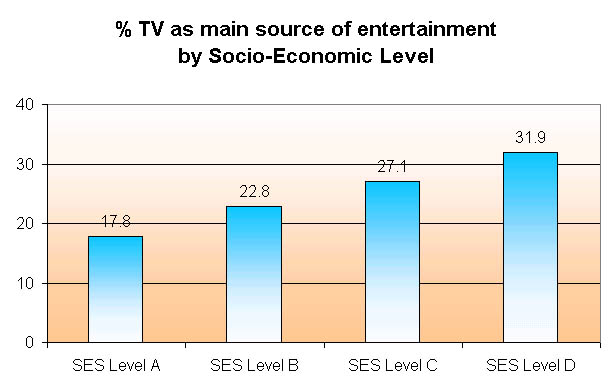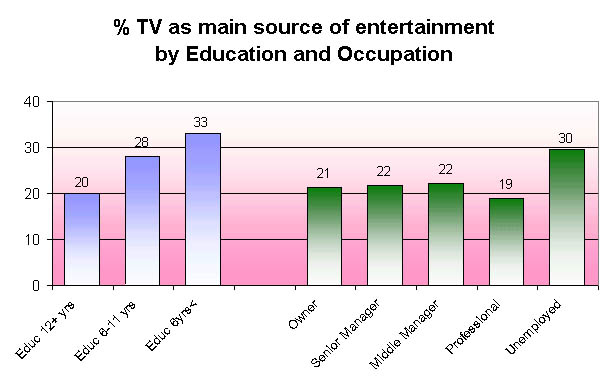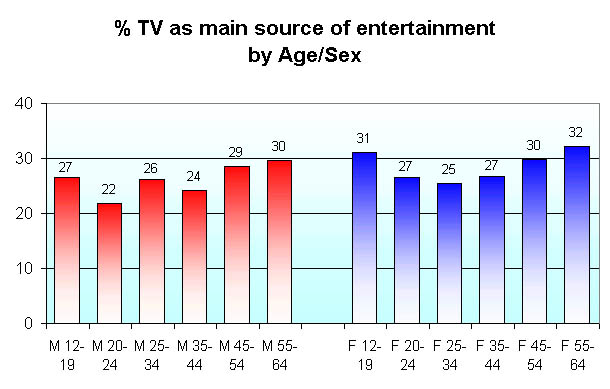
(source: TGI Latina)
Television As The Main Source of Entertainment
At the beginning of the twenty-first century, Latin Americans spend an average of three to four hours each day watching television, for entertainment and information. Those several hours assume even greater importance with respect to everyday life after we subtract the sleeping hours and the working hours from the full 24-hour day. Television is still a relatively new technology that appeared about fifty years ago and did not attain near-universal reach until ten to twenty years ago. Prior to the television era, people have different notions of entertainment --- just as parties, festivals, sports, concerts, theaters and cinema. But that list of activities was not universally accessible to all. For example, cinemas may not be present in rural areas, or else regular attendance may not be affordable for the socio-economic underclass. There are also scale limitations, as when a football stadium will not accommodate the whole population of the country. Television becomes the great democratic equalizer, bringing movies, football games and so on to the masses. Television also created new genres of entertainment, such as the vastly popular telenovelas.
It is not universally accepted that the effects of television are all beneficial. Among its alleged sins is the destruction of social and family values, whereby we have a populace of passive and alienated couch potatoes perched in front of the television screens every evening. Fifty or sixty years ago, people would be sitting outside talking to their neighbors. Today, people hide in their fortified homes and may not even know anything about whoever lives next door. We quote from Robert Kubey and Mihaly Csikszentmihalyi's book: Televising And The Quality of Life: How Viewing Shapes Everyday Experiences (introduction to Chapter 6):
TV has ruined American home life. People no longer sit around and visit. Everywhere you go you have to outtalk TV. TV people have entered your home and life more than people who should be friends and companions.
--- one of Gary Steiner's [1963] interviewees
When the TV set is on, it freezes everybody ... Everything that used to go on between people --- the games, the arguments, the emotional scenes, out of which personality and ability develop --- is stopped. So when you turn on the television, you turn off the process of making human beings human.
--- Bronfenbrenner [1983]
The television atmosphere in most households is one of quiet absorption on the part of the family members who are present. The nature of the family social life during a program could be described as "parallel" rather than interactive, and the set does seem quite clearly to dominate family life when it is on.
--- Maccoby [1951]
Television seems to have changed the ways in which family interaction occurs. When the set is on, there is less conversation and less interaction. There is more privatization of experience: the family may gather around the set, but they remain isolated in their attention to it.
--- National Institute of Mental Health [1982]
One of the longstanding, unresolved controversies in mass communication research is whether the use of television and other media interferes with the conduct of family life. For Frankfurt School theories a central fact of capitalism was the decline of the family as an agent of socialization. In this view, the socialization role of the family is partly passed on to the media and as a result, the audience becomes passive and one-dimensional (Horkheimer & Adorno, 1972; Marcuse, 1964).
Indeed, since the first days of its massive popularity in the early 1950s -- and in the days since --- television has been conceived by some to constitute an overwhelmingly dominant presence in the home --- a presence that interferes with family interaction and the process of socialization itself.
Other observers consider the television set to be a relative unthreatening home furnishing. In fact, there is a fair amount of research suggesting that viewing may be linked to more frequent and positive family interactions. As early as 1949, Riley, Campbell and Ruttiger claimed that television's presence in the home enhanced family togetherness, because it provided one of the few opportunities for family members to spend time together, helping to close the gap between adults and children. In this view, television viewing is conceived of as being well integrated with the rest of everyday life and posing little threat to human welfare. Wilensky (1964), however, was dubious about families watching "violent, escapist television" and advised that "students of the media who stress the absorption of television into the warm bosom of the family and peer group ponder what is being absorbed most effectively by whom with what effect." (p.183).
There are many explanations for these differing views. For one, researchers often examine different aspects of a phenomenon and only see part of the puzzle. And when it comes to television, scholars and critics are sometimes prone to arrive at singular conclusions about television's impact when in reality, behavior associated with television is quite complex. With regard to the family , some of this complexity was captured by Coffin's (1955) conclusion over 30 years ago that "Television is both credited with increasing the family's fund of common experience and shared interests and blamed for decreasing conversation and face-to-face interaction" (p.634).
But it is not the purpose of this article to argue for or against the relative social merits of television. Rather, we would simply like to assess the role of television as a source of entertainment for Latin Americans. We will now cite some survey data from the 2001 TGI Latina study. This is a survey of 48,885 persons between the ages of 12 to 64 years old in eight Latin American countries (Argentina, Brazil, Chile, Colombia, Mexico, Panama, Peru and Venezuela). During the survey, the respondents are shown a statement, "Television is my main source of entertainment" and 27.1% of these people said that they completely agreed. So, for more than a quarter of the population, television is the main source of entertainment.
In the next chart, we show the breakdown by socio-economic levels (where Level A is the top 10%, Level B is the next 20%, Level C is the next 30% and Level D is the bottom 40%). This is a monotonically decreasing agree rate by socio-economic level. Survey data such as these are straightforward --- one asks a question and one gets an answer. But the interpretation that can be put to such data may not be straightforward. For example, from this chart, one can postulate that this proves that the socio-economic elite have more diversified interests than what passes for entertainment on television. That may or may not be true. An alternate postulate may be that the socio-economic underclass do not have disposable income for entertainment purposes (such as going to discos). But whatever the causes are, the survey data indicate that television has different importance by socio-economic class.

(source: TGI Latina)
Given the results by socio-economic level, this next chart is unsurprising. By education, the levels are a monotonically decreasing function of educational level. By occupation, the levels are lowest among business owners, managers and professionals and highest among the unemployed.

(source: TGI Latina)
In the next chart, we show the breakdown of the responses by age/sex groups. By sex, the levels are slightly for females than males most of the time. By age, this is a U-shaped distribution with the levels being highest among teenagers and old people. These patterns correspond to a life-cycle phenomenon, where social entertainment (e.g. clubs, discos, cinema, etc) is more important for the 18-34 age group, less so for those who are 45 years or older and less accessible to 12-year-olds.

(source: TGI Latina)
(posted by Roland Soong, 8/02/2002)
(Return to Zona Latina's Home Page)